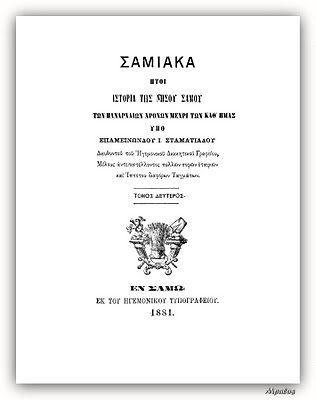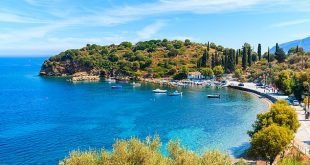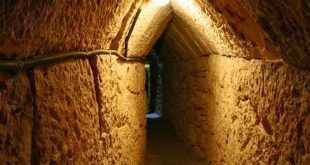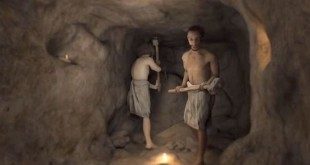The book “Samiaka” (5 volumes, 2.955 pages, and 13 x 23 format) was printed in the Princely Printing-Shop of Samos between 1881 and 1889, following a resolution passed by the “General Assembly of the Samian”. So, from this point of view, it is considered as a pioneer sample of a scientific piece of work being completed with the direct support of the polity.
Over time, the book has won its place among the most basic academic contributions of the last 100 years and covers all the chapters that constitute the history of a place. But this generalization has not damage the thorough research of the individual. Each chapter covers in detail known and unpublished material, submits information, verified and unverified, but always wisely and well commented. These information may refer to the glorious past or to the “recent” but untold histories of 1821 War of Independence or to the “eminent Samians” of all times or even to the perennial villagers who lived during the same period of time as the author did.
Such universal consciousness of our past is not common, since the scientific interest, up until now, is shared rather unequally between the Ancient and the Modern Greek History.
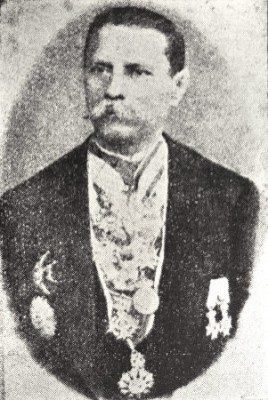 Stamatiades justifies, with an advanced understanding, events and situations. His ardent patriotism is rather convincing and tragic, but, nonetheless, it defeats the laxity, which is cultivated by the use of Purist Greek. Lastly, he presents many and abundant evidence.
Stamatiades justifies, with an advanced understanding, events and situations. His ardent patriotism is rather convincing and tragic, but, nonetheless, it defeats the laxity, which is cultivated by the use of Purist Greek. Lastly, he presents many and abundant evidence.
From this point of view, the second volume, in particular, is priceless. However, the author does not mention his sources for any information given, which is a serious handicap, compare to the modern bibliographical requirements. However, these requirements are becoming, unfortunately, rather unrealistic within a framework of successive calamities, fires, wars, humanitarian disasters, and the destruction of the material and spiritual wealth, as a direct result and inevitable consequence of such catastrophes. However, sooner or later, a modern historian will undertake this supplement. But when we consider how many “papers” we have thrown to the air and how many were sold by the numbers, the information available in “Samiaka” are regarded both as valid and reliable, even though it is not possible to simultaneously review the original texts and sources.
Besides as long the scientific criteria are defined and specified in a clear manner, the respect for what is in question (and this is very specific), along with a parallel admiration for the live testimonials, has been developed. So it is possible to find or not the decision made on April 12, 1822: “Common will and opinion of all the inhabitants” … etc., “… to govern our fatherland” and “we promise this”, the “ten and eight villages of the island”. But the text, as we read in the second volume, page 217, is an immortal monument, something that lives forever, and is verified by deeds.
Two reasons explain, without justify thought, how “Samiaka” remained relative unknown to their “greater” (i.e. Greece) and the “smaller” (i.e. Samos) country:
Global unrests prevented any peaceful evaluation of history. During these global unrests Samos always found itself on the front line of sacrifice.
The Purist Greek limited, and continues to limit, the shining even of the most genuine wisdom. It “keeps” it away from the public, which, whether we like it or not, accepts or reject each and every offer made over the time.
A last but not least reason is, in my opinion, a quite serious one: Many have “borrowed” or even copy information from Stamatiades’s work and yet they didn’t consider it necessary to mention the source.
Elli Papadimitriou, “Samos”, 1959 (the grammar and spelling of the original text has been preserved here).
 iSamos.gr Η ενημερωτική σελίδα της Σάμου! Εξερευνήστε τη Σάμο, τις παραλίες της, τη φύση της, τις ομορφιές της. Διαβάστε την ιστορία της Σάμου
iSamos.gr Η ενημερωτική σελίδα της Σάμου! Εξερευνήστε τη Σάμο, τις παραλίες της, τη φύση της, τις ομορφιές της. Διαβάστε την ιστορία της Σάμου

